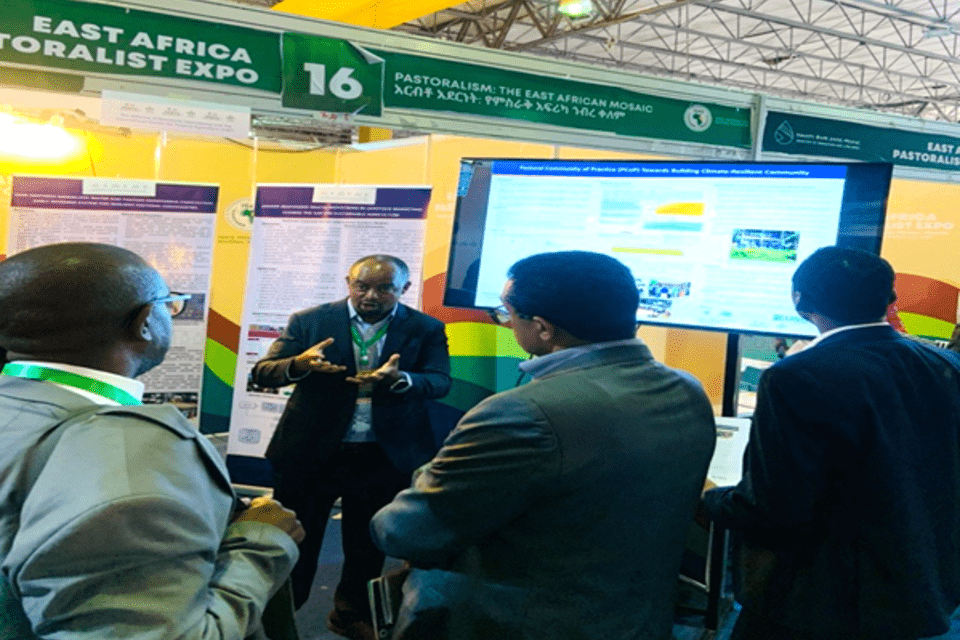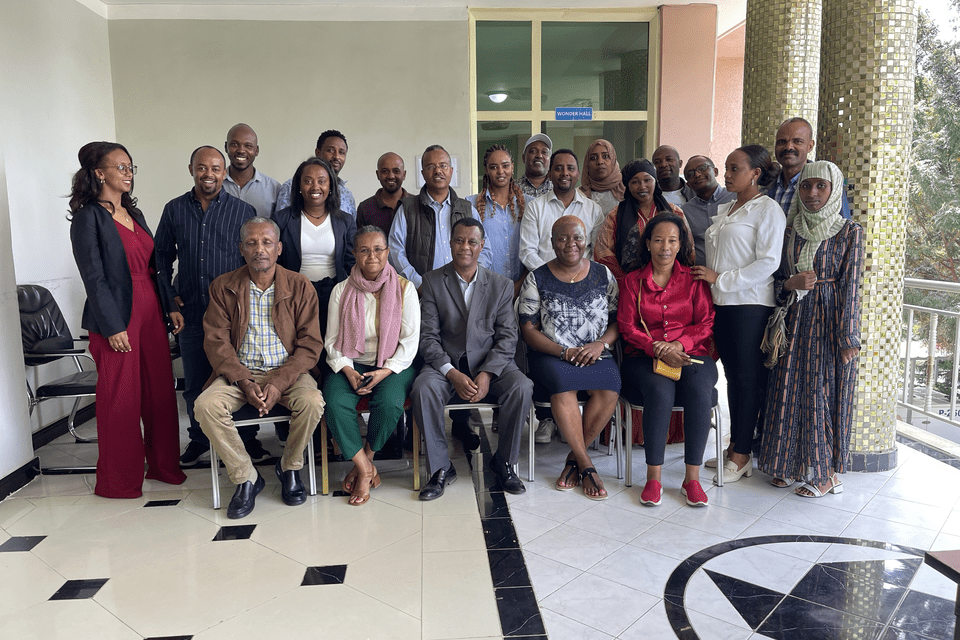Press and News Transforming Resilience in Pastoral Areas of Ethiopia: The Launch of a User-Centered Integrated Rangeland and Water Monitoring and Early Warning System in Pastoral areas of Ethiopia

In a world grappling with the challenges of climate change, the need to empower communities and build resilience has never been more crucial. The Alliance of Bioversity International and the International Center for Tropical Agriculture (CIAT) held a half-day workshop at the Hyatt Regency Addis Ababa launching the User-Centered Integrated Rangeland Water Monitoring and Early Warning System That Empowers Pastoralists Unveiled.
By: Sintayehu Alemayehu, Numery Abudlhamid, Lidya Tesfaye; Yodit Yaregal Seyoum, Sintayehu Workeneh, Liyuneh Gebre
The workshop marked a significant milestone in the pursuit of sustainable development. Supported by the generous contribution from the Bill and Melinda Gates Foundation (BMGF), this groundbreaking project, led by the Alliance of Biodiversity International, CIAT, in collaboration with the Ethiopian Ministry of Agriculture (MoA), and the Ethiopian Institute of Agriculture Research (EIAR), promises to revolutionize resilience and adaptation in pastoralist communities facing dire climate change risks.
By integrating technology through real-time data, a Human-centered design (HCD) approach, and indigenous knowledge, the platform will empower pastoral communities to make risk-informed decisions to adopt and build resilience towards climate change impacts. Additionally, the platform will enhance collaboration and coordination among decision-makers, researchers, and other stakeholders to make data-driven decisions utilizing web-based tools. Through site-specific information on the relative depth, rainfall, and evaporation level of the water surface/waterhole the tool will provide timely and accurate data enhancing decision making.

The workshop participants gathered for a brief networking break.
The half-day workshop brought together diverse stakeholders including officials from the Ethiopian Government institutions, respective Kenyan officials, Community representatives, Non-Governmental Organizations (NGOs), funding partners, private sector, media as well as research and academia. Through informative technical presentations and panel discussions, participants engaged in lively discussions, exchanging best practices, and exploring practical implementation strategies.
The workshop which aimed at bringing together key stakeholders to adopt and use the platform for building resilience in the pastoral areas of Ethiopia deliberated on the following key themes:
-
Launching the water, pasture and climate monitoring and forecasting platform,
-
Highlight the role of the system in monitoring and managing lowland resources, contributing to national efforts in building climate-resilient systems.
-
Emphasize the importance of research-based decision-making and drought management supported by the system.
-
Establish the need for an early warning system to enhance the adaptive capacity of pastoralist communities.
-
Explore the system's potential to support decision-making at local, national, and regional levels while strengthening advocacy efforts.
-
Examine how the system can be scaled up to address transboundary environmental challenges in the East African region, and how it can assist the Kenyan government in making well-informed decisions for pastoral regions.
The workshop officially opened with a traditional blessing from a Gada elder followed by an opening speech by H.E. Dr. Fikru Regassa, State Minister for the Ministry of Agriculture who acknowledged the critical need for an integrated platform that empowers pastoral communities by providing timely and personalized information on water and pasture resources, thereby enhancing livestock risk management practices, and building resilience.
“Today signifies a landmark moment on our path to achieving sustainable growth and building resilience in pastoral areas of Ethiopia. The introduction of this User-Centered Integrated Rangeland and Water Source Monitoring and Early Warning System heralds a new chapter of innovation and collaborative effort aimed at improving the lives of our pastoral communities amid the challenges posed by climate change and environmental degradation.”
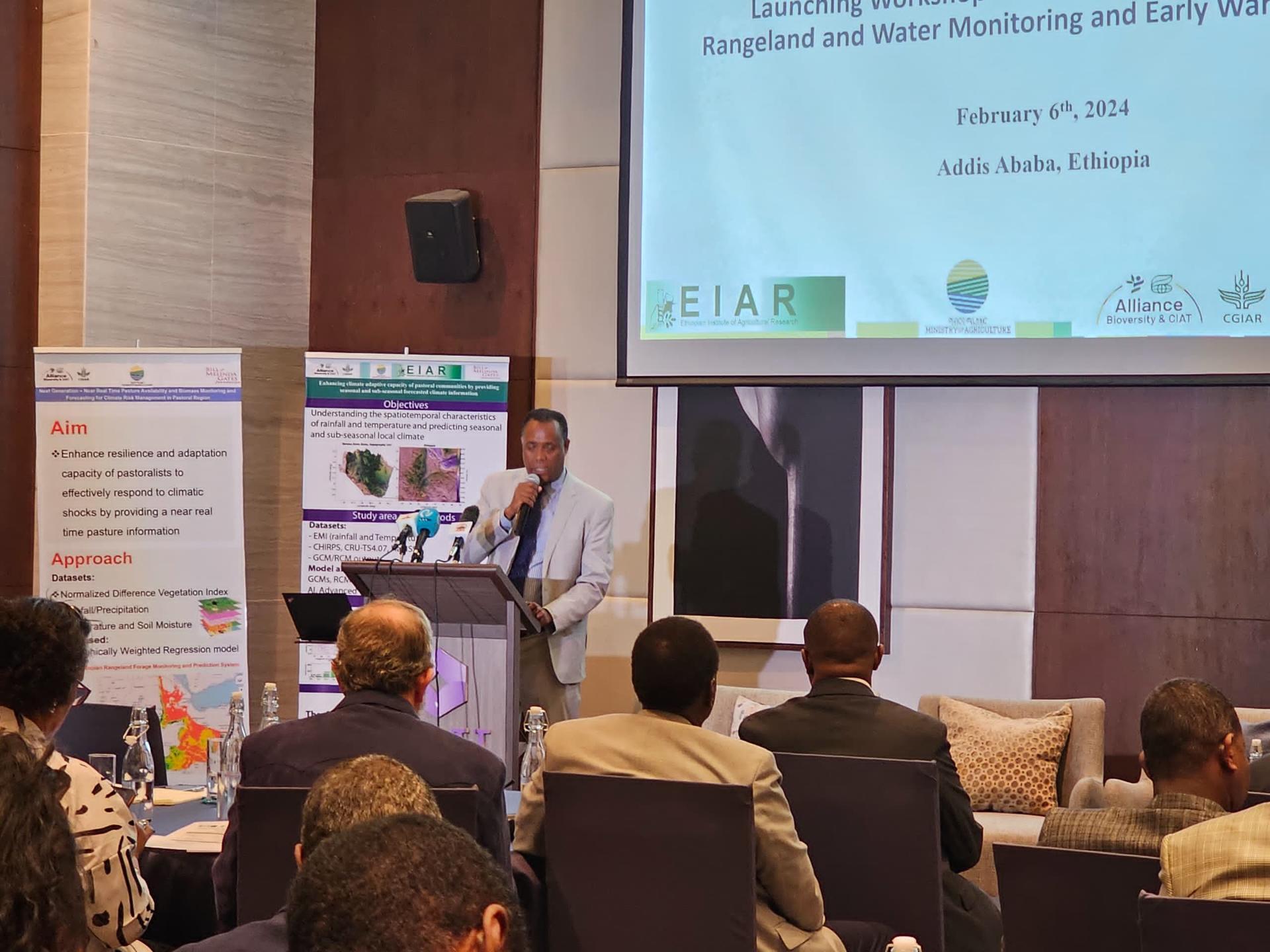
H.E. Dr. Fikru Regassa, State Minister for the Ministry of Agriculture delivering an opening remark.
The Minister reinforced the symbolic significance of the tool as Gov’t reaffirms commitment to continue supporting drought-affected people and the preservation of the natural environment, economy, and communities. The Minister also celebrated the noteworthy achievement of the Alliance of Bioversity International and CIAT, MOA, and EIAR in reaching this significant milestone.
The workshop featured a series of technical presentations that shed light on the intricacies of the user-centered integrated water and pasture monitoring system. Sintayehu Alemayehu, a Scientist at Alliance Bioversity and CIAT and project leader, presented the challenge, objectives and goal, demand as well as methodologies applied during the project followed by an expert demo led by Liyuneh Gebre, Associate Researcher at EIAR, demonstrated how different personas representing pastoral women, experts, and decision-makers were used to address varying needs, technological capacities, and access requirements.
Following the presentations, a panel discussion of diverse stakeholders served as a dialogue stage to delve into the opportunities and prospects for implementing and scaling such a transformative decision-support system. One of the distinguished panelists, Bernard Kimoro, Head of Climate Change and Livestock Sustainability at the Kenyan Ministry of Agriculture and Livestock Development, recognized that pastoralists are constantly on the move in search of essential resources such as water and pasture. He highlighted that the launched system considers these dynamics, as they could potentially lead to interstate conflicts over shared resources in the region further emphasizing the transboundary nature of climate risks necessitating collaborative efforts to address them.
Bernard highlighted that this project presents an opportunity for future collaboration among the cluster of pastoralists encompassing Ethiopia, Somalia, and Kenya. He commended the launched system, referring to it as a “Game-changer” and stressed the need for a strategy to scale the system's impact beyond Ethiopia's borders.

Dr. Namukolo Covic, CGIAR Ethiopia Country Convenor CGIAR Regional Director for East and Southern Africa.
Another notable panelist, Dr. Namukolo Covic, CGIAR Ethiopia Country Convenor CGIAR Regional Director for East and Southern Africa, emphasized the significance of early warning systems extending beyond adaptation measures and enhancing proactive decision-making and long-term planning. They applauded the utilization of the Human-Centered Design (HCD) approach in the development of the tool, which supports decision-making processes for different stakeholders in building resilience even during favorable periods. The panelist also highlighted the tool's usefulness for researchers, enabling them to make informed assessments of future scenarios and develop corresponding solutions in the present.
Dr. Tess Russo, Senior Program Officer at the Bill and Melinda Gates Foundation (BMGF), who was also one of the panelists, shared that addressing sustainability concerns is a priority and praised the project as an exemplary model that showcased the effective utilization of HCD principles in developing a user-friendly platform that plays a vital role in tackling this aspect. Dr. Russo acknowledged the importance of continuously assessing and analyzing the platform to enhance its performance and ensure its effectiveness in meeting the needs of the target users. The panelist also highlighted that information generated by the platform will be invaluable for water resources development and management.

Dr. Tess Russo, Senior Program Officer at BMGF.
In summary, the panel discussion underscored the importance of the platform for stakeholder engagement, and collaboration, as well as the role of technology in addressing the unique needs of pastoralist communities while preserving their livelihoods and cultural identity. It also highlighted the critical role of the tool in reducing vulnerability to future climate risks, enhancing climate mitigation actions, reducing conflicts, and informing key policy decisions.
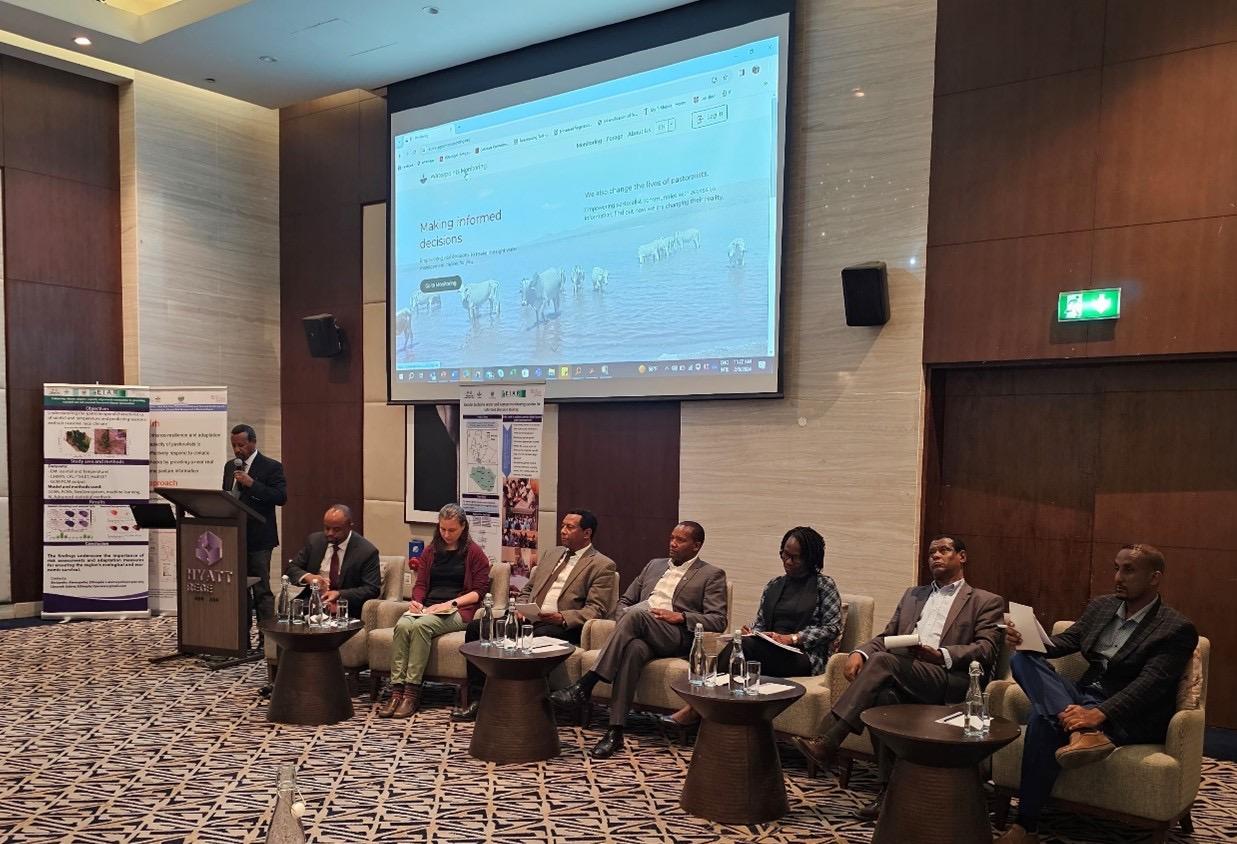
Distinguished panelists deliberating the different role of the system.
The plenary discussion allowed participants to address challenges and opportunities related to technology adoption, capacity building, accessibility, and scalability of the user-centered integrated water, pasture and climate monitoring and forecasting system. Konsicha Bukke, an elder and Borana Pastoralist representative from Yabello woreda, emphasized the platform's significance in enhancing their indigenous resource management of the four main resources— soil, pasture, water, and land—on which pastoralist communities depend while ensuring the sustainability of their way of life. Mr.Konsicha also added that the current platform is need based decision support tool implying good prospect for sustainability.
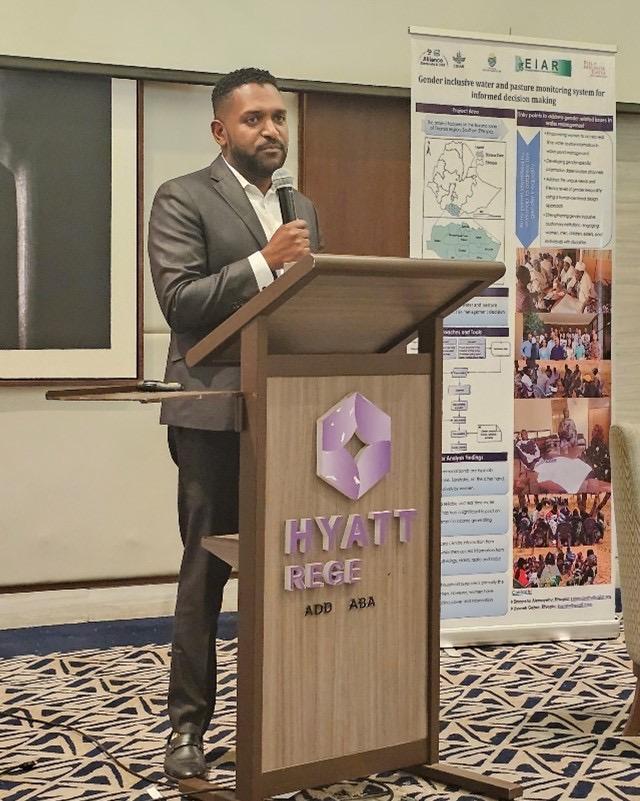
In his closing remarks, Eng. Hizkias Dufera, Senior Advisor at the Ministry of Irrigation and Lowlands, reflected on the remarkable efforts that have been made to create a more resilient and sustainable future for the low-land areas of Ethiopia. Shedding light on the invaluable insights drawn from the panelists, he emphasized, “This initiative represents a significant leap forward in our capacity to predict and respond to environmental and climatic challenges. Through the integration of cutting-edge technologies and data analytics, the system promises to revolutionize our approach to disaster risk reduction and climate resilience.” Eng. Hizkias expressed his appreciation for the Alliance team, EIAR, MoA and the development of the tool, urging all stakeholders and participants to strengthen collaboration for the systems.
The launch of the user-centered integrated water, pasture, and climate monitoring and forecasting system represents a significant step towards digitizing resilience in pastoralist communities. In his interview with the Ethiopian News Agency (ENA), Sintayehu reveals, “The project that we are currently implementing is called early warning system that has a capability to predict pasture and water availability in the pastoral region of Ethiopia. We are now piloting this project in Borena, Oromia Regional State, one of the highly dominated livestock populations, particularly cattle.”

By harnessing technology, data, and collaboration, this innovative platform has the potential to empower communities, inform decision-making, and contribute to sustainable development. Thereby, the workshop catalyzed collective action, marking a successful launch of the platform and its adoption by the Ethiopian government for building resilience in the pastoral areas of Ethiopia, while further affirming the need for scaled-up use of the platform beyond Ethiopia to provide a transboundary solution to climate change risks in pastoral areas of Horn of Africa.
The Team

Sintayehu Alemayehu
Project Leader
Sintayehu Workeneh Dejene
Research Management Coordinator
Lidya Tesfaye
Research OfficerSee Also
